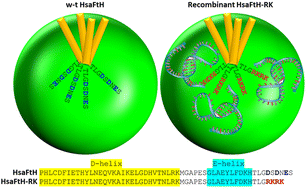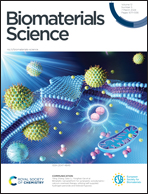Engineered human H-chain ferritin with reversed charge of the internal cavity exhibits RNA-mediated spongelike effect for loading RNA/DNA-binding molecules†
Abstract
Ferritins are globular proteins with an internal cavity that enables the encapsulation of a plethora of low-mass compounds. Unfortunately, the overall negative surface charge of ferritin's internal cavity hampers efficient loading of negatively charged molecules. Therefore, we produced a genetically engineered human H-chain ferritin containing a cationic RKRK domain, reversing the natural net charge of the cavity to positive, thus allowing for efficient encapsulation of negatively charged siRNA. Due to the reversed, positive charge mediated by RKRK domains, the recombinant ferritin produced in E. coli inherently carries a load of bacterial RNA inside its cavity, turning the protein into an effective sponge possessing high affinity for DNA/RNA-binding substances that can be loaded with markedly higher efficiency compared to the wildtype protein. Using doxorubicin as payload, we show that due to its loading through the RNA sponge, doxorubicin is released in a sustained manner, with a cytotoxicity profile similar to the free drug. In summary, this is the first report demonstrating a ferritin/nucleic acid hybrid delivery vehicle with a broad spectrum of properties exploitable in various fields of biomedical applications.



 Please wait while we load your content...
Please wait while we load your content...